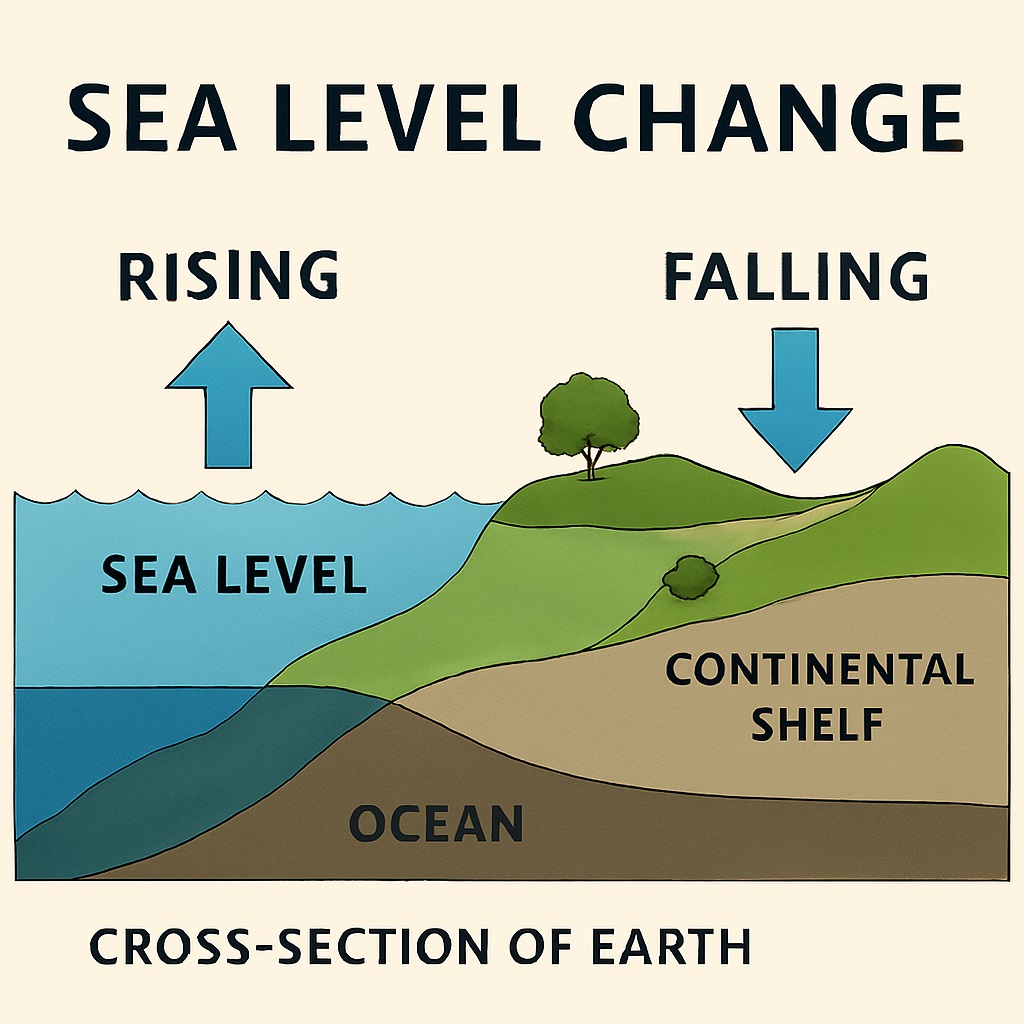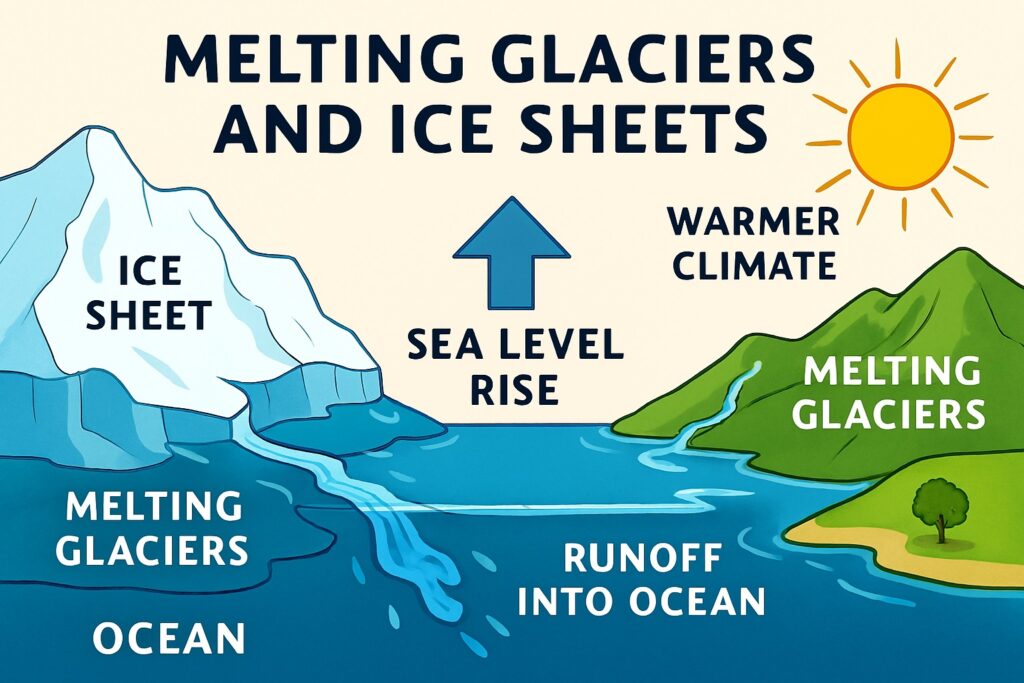Sea level changes represent one of the most impactful signals of our planet’s dynamic nature. These variations are not merely measurements on a scale, they tell a story of Earth’s climate, geology, and the intricate dance between ice, water, and temperature. Sea level changes are a crucial aspect of geographical studies, influencing coastal landscapes, ecosystems, and human settlements. These changes can be driven by natural processes and anthropogenic influences, creating long-term and short-term variations in ocean levels.

Table of Contents
Mechanisms Behind Sea Level Change
- Thermal Expansion and Contraction: As the ocean water warms, it expands—a phenomenon known as thermal expansion. Conversely, when water cools, it contracts. Over decades, even small temperature shifts can lead to significant changes in sea level.
- Glacial and Ice Sheet Melt: The addition of water to the oceans through melting glaciers and ice sheets is another major contributor. During warmer periods, when the polar and mountain ice recedes, the cumulative effect increases sea levels. Such changes are especially prominent in the context of modern-day climate change.

Sea Level Rise by Melting ice - Glacial Isostatic Adjustment (GIA): Beyond climate-related factors, the Earth’s crust itself responds to the weight of ice. After the massive ice sheets of the last Ice Age melted, the land began to rebound—a process still ongoing in regions like Scandinavia and Canada. This vertical movement can alter local relative sea levels even if global sea levels remain stable.
- Tectonic Activity: The movements of the Earth’s tectonic plates can also cause changes in the elevation of coastal regions. Uplift or subsidence of the land alters the relative sea level at a given location, adding another layer to this complex process.
Each of these factors interacts in a global context, making the study of sea level changes a truly interdisciplinary challenge that blends climatology, oceanography, geology, and geography.
Historical Sea Level Trends
The Earth’s sea levels have not been constant. During the last glacial maximum, approximately 20,000 years ago, vast quantities of water were locked away in ice sheets, resulting in sea levels that were significantly lower than today. As the climate warmed, these ice reserves melted, leading to the rapid post-glacial rise in sea levels—a process that has smoothed the continents and reshaped coastlines over millennia.
Fossil records and sediment layers have enabled geographers and paleo climatologists to reconstruct these dramatic changes. Learning from historical sea level fluctuations not only gives us insight into past climates but also serves as a cautionary tale about the potential consequences of our current warming trajectory.
Impacts on the Environment and Human Communities
The ramifications of sea level changes are profound and multifarious:
- Coastal Erosion and Land Loss: Even gradual rises in sea level can accelerate coastal erosion, washing away beaches and leading to the loss of critical habitats for both humans and wildlife.
- Increased Flooding: Rising seas mean that storm surges and high tides can inundate coastal communities more frequently and severely, increasing the vulnerability of infrastructure and populations.
- Saltwater Intrusion: As sea levels rise, salty water can encroach into freshwater reserves, affecting drinking water supplies and agricultural practices in coastal regions.
- Ecosystem Disruption: Coastal ecosystems such as mangroves, estuaries, and wetlands—which serve as natural buffers against storms—are at risk, potentially triggering cascading effects on biodiversity and local livelihoods.
These impacts are not isolated; they intertwine with human activities, urban planning, and natural resource management, urging policymakers and scientists to collaborate in a search for sustainable adaptations.
Monitoring and Future Projections
Modern technology has revolutionized our ability to monitor sea level changes. Satellite altimetry, tide gauges, and GPS measurements allow scientists to track even the minute variations in sea level worldwide, offering precise data essential for modelling future changes. Research consistently shows that current rates of sea level rise are accelerating, largely due to the ongoing effects of global warming.
Future projections vary by region, but many coastal areas face significant risks. Urban centers, agricultural lands, and critical ecosystems may need to adapt rapidly. Failure to address these challenges could lead to increased economic costs, displacement of communities, and profound environmental degradation.
Mitigating the Threat of Sea-level Rise
There are a number of steps that communities can take to mitigate the threat of sea-level rise. Some of the most effective strategies include:
- Planning and Zoning: Communities can implement planning and zoning policies that reduce the risk of flooding and shoreline erosion. For example, communities can designate areas that are vulnerable to flooding as conservation areas, or restrict development in these areas.
- Coastal Defence: Communities can also implement coastal defense measures, such as building sea walls, dikes, and other structures to protect against flooding and shoreline erosion.
- Green Infrastructure: Communities can also implement green infrastructure, such as vegetated dunes and marshes, to absorb the impact of waves and reduce the risk of flooding.
- Adaptation Measures: Communities can also implement adaptation measures, such as relocating vulnerable infrastructure and communities to higher ground, or installing early warning systems to alert residents of potential flooding.
Conclusion
Understanding sea level changes is to embrace the broader narrative of Earth’s dynamic systems—a tale of balance between heat and cold, water and ice, land and sky. As we observe the rising tides, it becomes clear that our coastal landscapes are living laboratories where the interplay of climate, geology, and human influence is writ large. For planners, scientists, and communities alike, the challenge lies in predicting, preparing for, and ultimately mitigating the impacts of a world where even the seas are in constant flux.
Sea-level rise is one of the most significant consequences of climate change. It is caused by the melting of glaciers and ice sheets, as well as the thermal expansion of the ocean. The rise in sea level poses a threat to coastal communities around the world, as it can lead to flooding, shoreline erosion, and other coastal hazards. In this article, we will discuss the causes of sea-level rise, its impacts, and the steps that communities can take to mitigate the threat.
